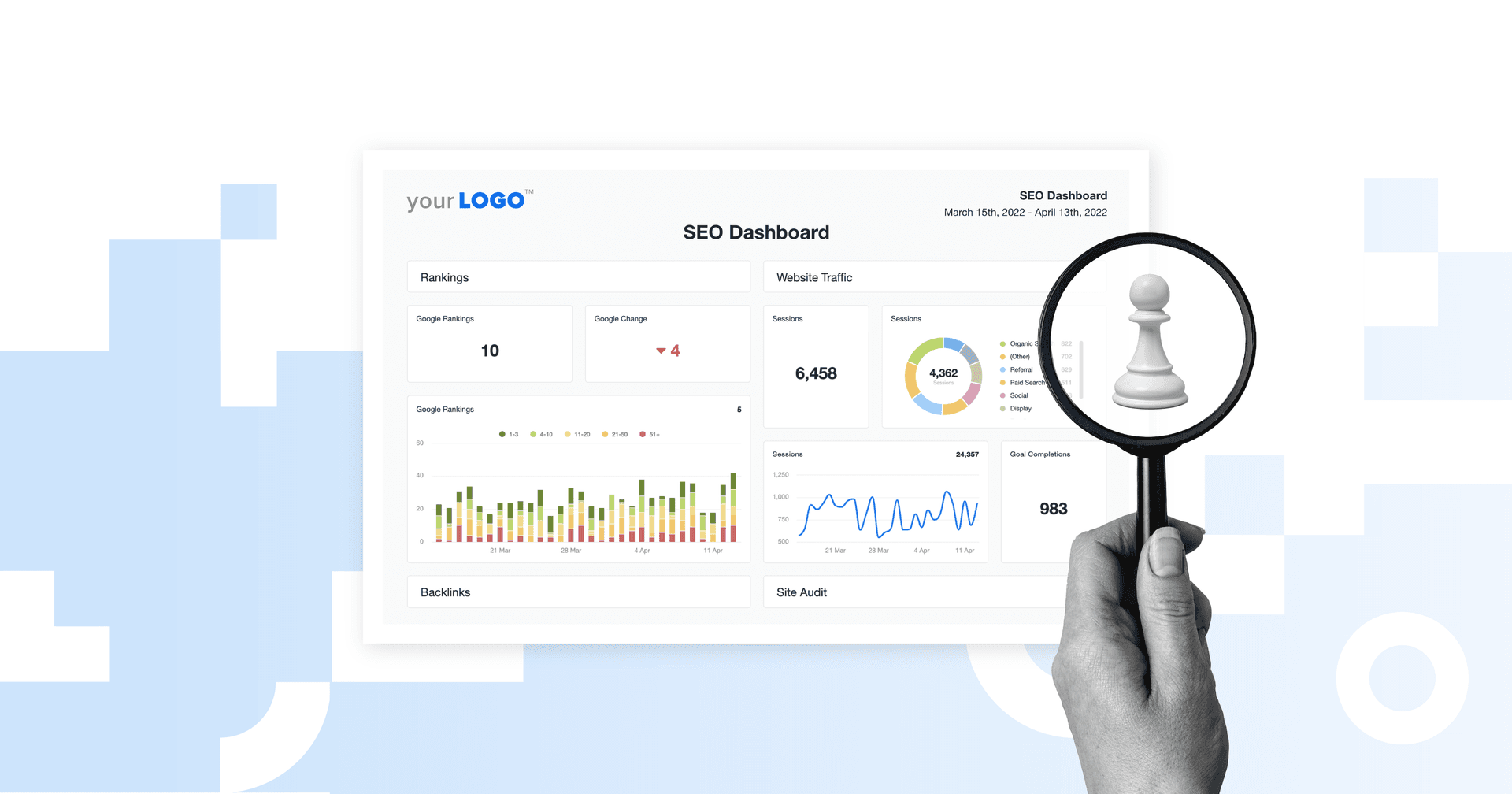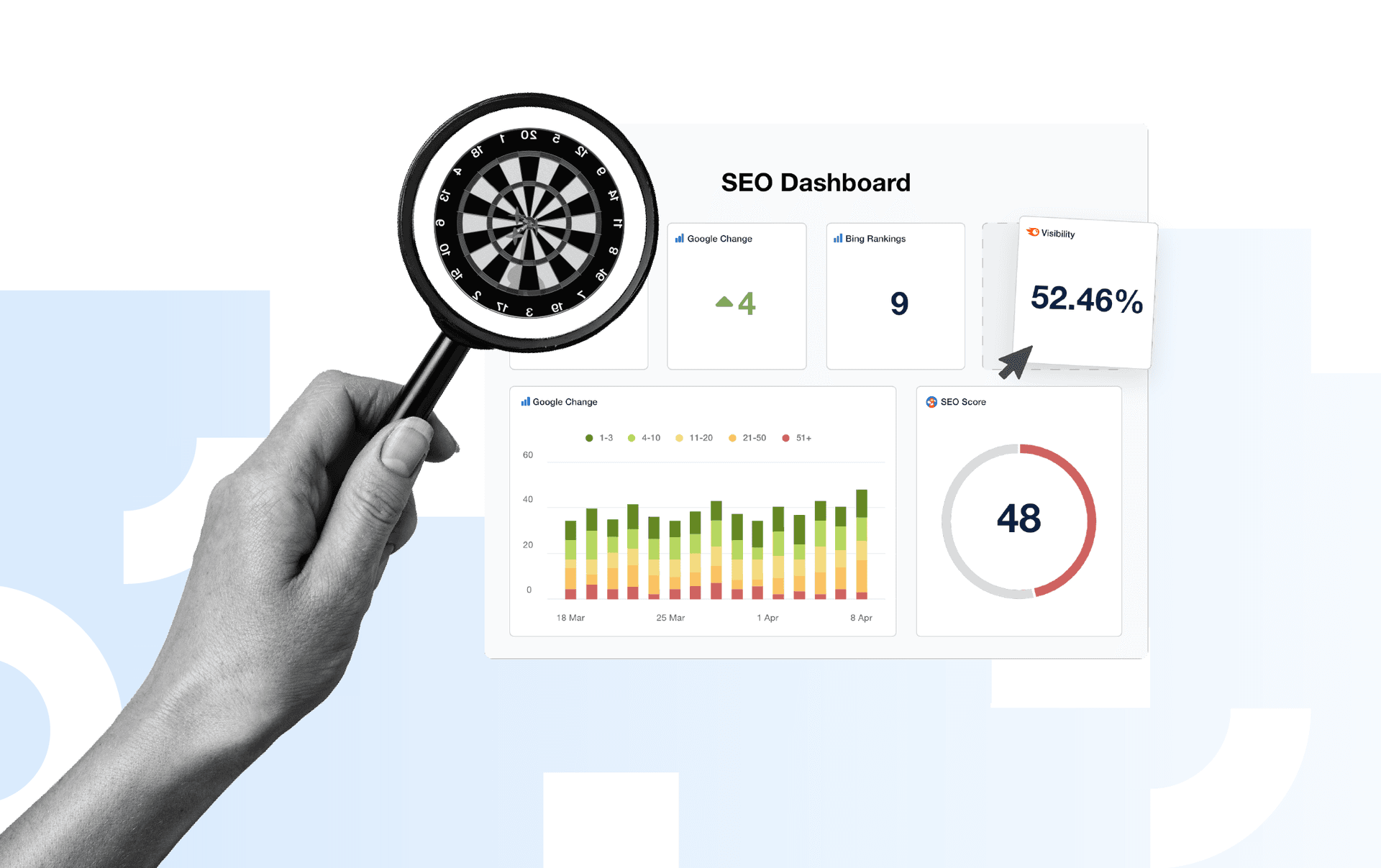Table of Contents
Table of Contents
- What Is SEO Forecasting?
- Why SEO Forecasting Matters for Agencies
- Why Is SEO Forecasting Notoriously Difficult?
- Methods & Models Used in SEO Forecasting
- Why Both Methods Matter
- Common SEO Forecasting Pitfalls & How To Avoid Them
- The Dangers of Over-Forecasting
- Top SEO Forecasting Tools & Software
- Final Thoughts
7,000+ agencies have ditched manual reports. You can too.
Free 14-Day TrialQUICK SUMMARY:
Struggling to create SEO forecasts your clients can trust? This guide shows agencies how to predict SEO performance using two proven methods. Learn how to build smarter forecasts, avoid common pitfalls, and turn insights into strategic growth.
Between algorithm shakeups, shifting search intent, and new SERP features stealing clicks, forecasting SEO performance has never been tougher.
And analyzing client data? It takes time, and often delivers insights too late to act on.
But clients still expect answers. They want to know how much traffic to expect, how soon, and what it means for their bottom line.
That’s where SEO forecasting becomes your agency’s competitive edge.
When done right, it sets the stage for smarter SEO strategy, better resource planning, and rock-solid client trust. When you master it, you’ll find that you’re not just reacting to change but leading with clarity and confidence.
So, is your SEO forecasting dialed in? Or are you still making educated guesses?
This guide breaks down the two forecasting methods every agency should use, with practical steps to turn traffic estimates into strategic proof.
Read on to build forecasts that help you retain clients and win bigger SEO contracts.
What Is SEO Forecasting?
SEO forecasting predicts how much organic traffic a website might generate over a specific period. It helps agencies and clients decide where to invest budget and resources, how to pace campaigns, and what kind of ROI to realistically expect from SEO efforts.
Agencies typically forecast search traffic, conversions, or even revenue tied to organic search results. The best forecasts are built from a mix of:
Search volume and keyword rankings, often sourced from keyword research tools or Google Search Console
Historical data on organic traffic trends and previous SEO performance
Conversion benchmarks from Google Analytics, including website traffic and lead data
Seasonality, user behavior shifts, and emerging search trends.
Before we get into how to create SEO forecasts, let’s discuss why forecasting is mission-critical in today’s SEO environment.
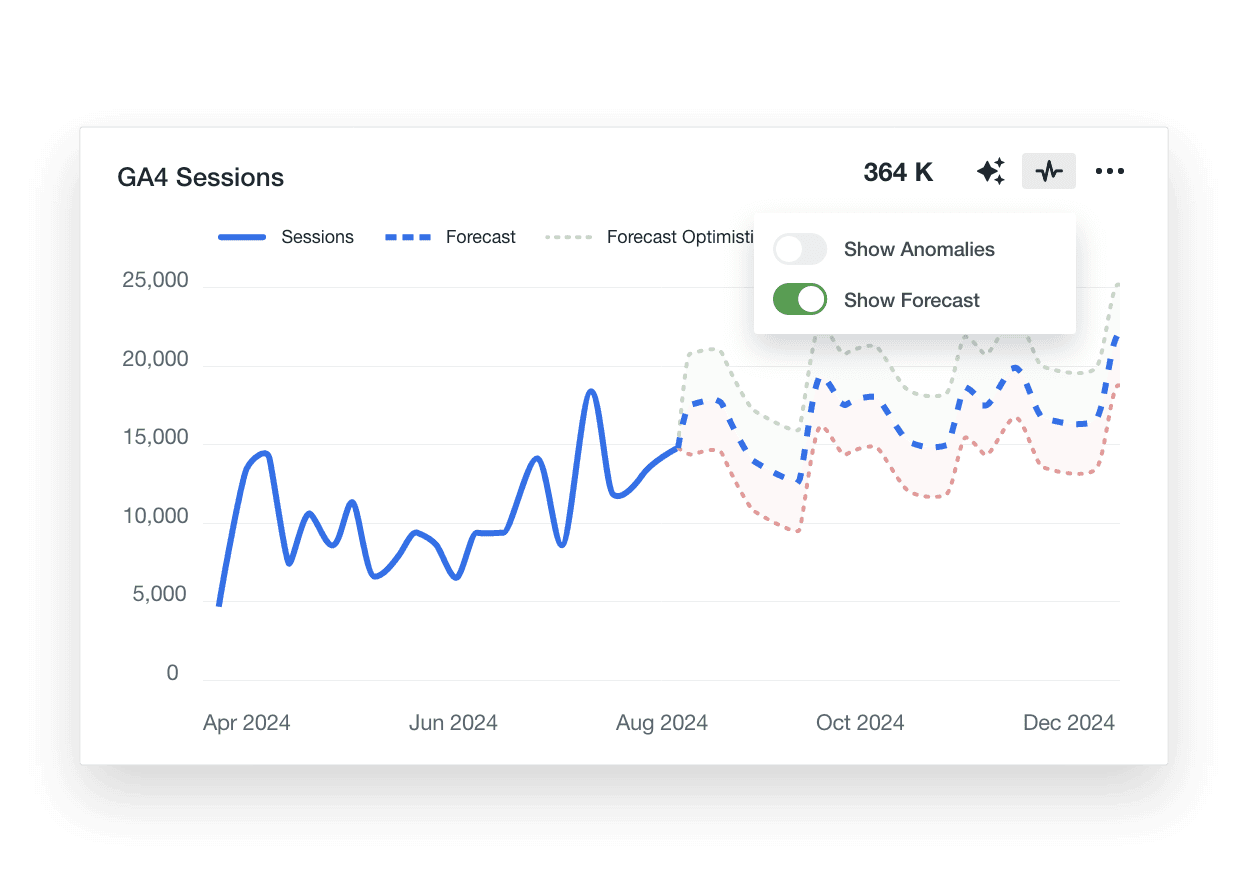
Why SEO Forecasting Matters for Agencies
Accurate SEO forecasting has the power to reshape the entire agency relationship. It gives you leverage in strategy, clarity in execution, and confidence in every conversation.
Here’s why it matters at every stage of your agency’s workflow:
Builds Trust and Justifies Budget
Clients don’t want SEO reports of what’s been done; they want to know what’s next. Forecasting future performance gives them that clarity. It also helps you demonstrate when a bigger budget or new SEO tools are needed to close the gap or outpace competitors.
Helps You Prioritize High Impact Work
When you forecast SEO traffic based on search volume and CTR, it’s easier to focus on the work that offers the most traffic potential. This keeps your team laser-focused on what actually drives organic search results.
Improves Client Retention
Forecasts turn client check-ins into strategic conversations. Instead of defending last month’s dips, you’re guiding clients through a bigger picture where SEO growth is mapped, measurable, and future-focused. That trust builds loyalty.
Guides Resourcing and Internal Planning
Forecasts aren’t just for clients; they help you plan accordingly too. If your traffic forecast shows a 40% lift over the next 6 months, you’ll know whether to hire, outsource, or lean into automation to scale delivery without burning out your team.
Strengthens Your Sales Pitches
Adding SEO forecasts to your SEO proposals is a surefire way to set your agency apart. Predicting how much traffic a client could gain with increased effort or refined strategy helps you win business and stand out from other SEO resellers or consultants who rely on vague promises.
Agency Tip: Create SEO proposals in minutes using a free AgencyAnalytics SEO proposal template.
Gives You a Competitive Edge
When you analyze competitor SEO strategies alongside forecast data, you’ll find gaps in the search engine results pages they’re not covering. That insight helps you forecast organic traffic growth from underused keywords and content themes before your competitors catch up.
To summarize, forecasting isn’t a reporting layer. It’s a strategic asset!
Why Is SEO Forecasting Notoriously Difficult?
Accurate SEO forecasting offers many benefits, but the problem is that it’s incredibly challenging!
You’re essentially modeling future traffic in a system where nearly every variable can shift without warning.
Here’s why it’s so tough to forecast SEO growth:
Search Behavior Is Constantly Evolving: User behavior changes fast. Keyword search intent shifts, new trends emerge, and seasonality can swing search volume wildly. A keyword that drove traffic last quarter might flatline this one.
Search Rankings Are Never Guaranteed: Targeting a keyword doesn’t mean you’ll rank for it. Even if you do, the CTR drops sharply after the top three positions. Forecasting based on ranking assumptions is always a gamble.
Attribution Models May Undervalue SEO: Organic search often drives early-stage awareness, but many attribution models credit only the final touchpoint. That means SEO’s impact on conversions can be underrepresented, making ROI projections tricky.
Data Quality Is Often Compromised: Bots, branded traffic, and site anomalies can distort analytics. Many clients lack clean Google Analytics (GA4) setups or accurate conversion tracking, making it hard to base forecasts on reliable data.
External Factors Disrupt Predictions: Economic conditions, industry trends, and regulatory changes all impact SEO performance. These external factors are beyond your control and can hinder accurate forecasting.
Client Expectations Are Unrealistically High: Clients often expect forecasts to function as guarantees. One misstep, and you’re explaining why traffic dipped when the forecast said it should rise.
All of this means SEO forecasting requires clarity, caveats, and careful communication.
Methods & Models Used in SEO Forecasting
Now let’s explore two SEO forecasting methods to put to work, broken down step by step.
We’ll keep this example in mind:
Your client is a B2B multiple services provider offering managed IT and other services. You’re helping them grow their organic footprint with a new blog strategy targeting middle-of-funnel search traffic.
1. Keyword Forecasting Method
Keyword-based forecasting helps you estimate how much traffic your client could generate by ranking for specific terms. It’s ideal when you’re:
Pitching a new content strategy
Projecting ROI on a retainer
Justifying increased SEO investment
Working without access to historical traffic data.
Agency Tip: This method is highly theoretical. It assumes your client has enough domain authority, backlinks, and topical relevance to land on page one, ideally in positions #1–5. Always make that clear when presenting forecasts.
Step 1: Pull Search Volume for Targeted Keywords
Start with the list of keywords you’re planning to target. This is usually done for all the quarterly, bi-annual, or annual content topics, so you should have a solid list.
These might be terms like:
“Pros and cons of cybersecurity”
“Proactive managed services”
“IT infrastructure outsourcing”.
Drop all the keywords into a keyword research tool like Ahrefs or Semrush (the example below uses Ahrefs):
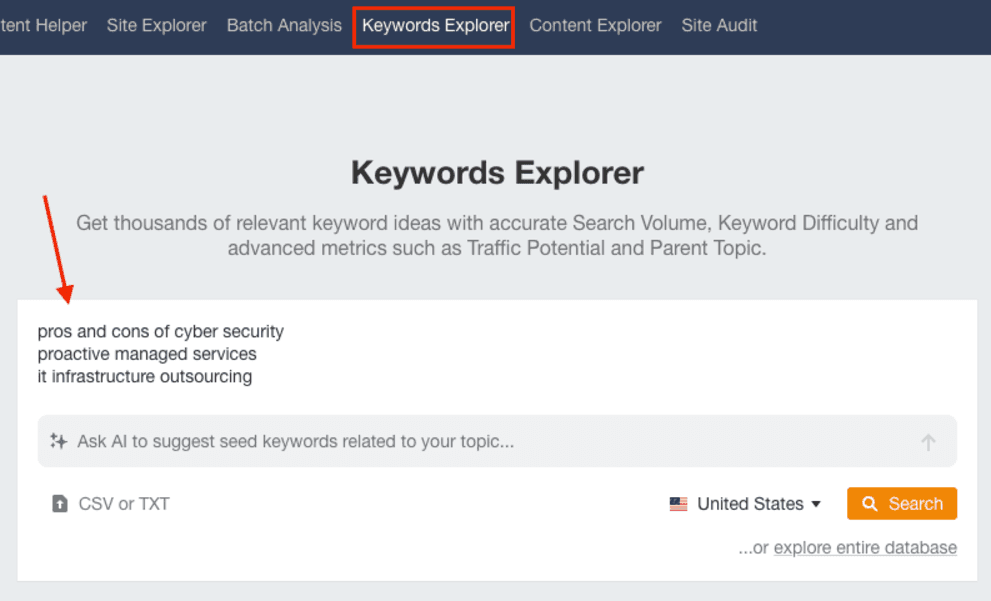
Agency Tip: Use the correct database for your client’s region (e.g., U.S. vs. Canada) to avoid skewed search volume estimates.
Next, export the data: monthly keyword search volume, keyword difficulty, and intent. This gives you a working dataset to build your forecast:
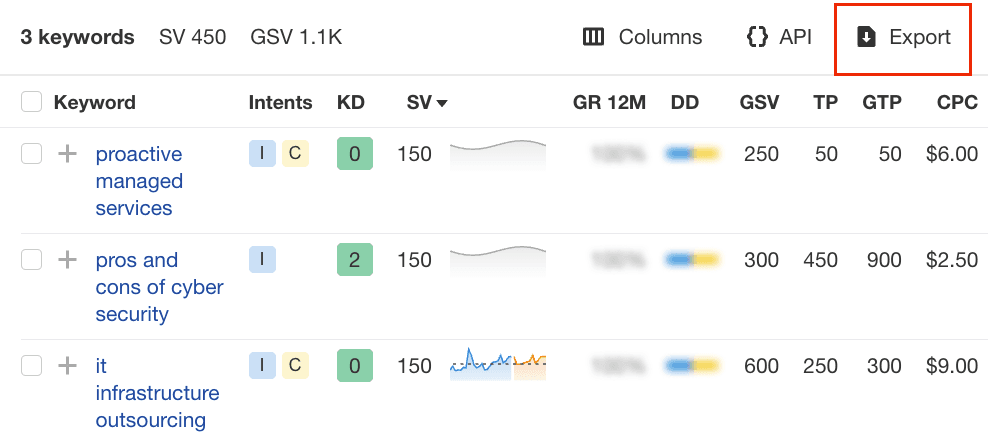
Unless your team uses Ahrefs regularly, you likely won’t have a Google Drive account connected to the export feature, so go ahead and download the first CSV option:

You’ll need to open this in Excel or Google Sheets. The end result will look like a slightly expanded version of this:

Step 2: Estimate Organic Traffic Based on Average CTR
Once you have the search volume, it's time to estimate how much of that traffic your client could realistically capture based on ranking position.
A) Use Current Page CTR (If Available)
Pull actual CTR data from Google Search Console if they already rank for similar terms. For example, if they get a 7% CTR in position #3, apply that rate to the new keywords as a starting estimate.
So, for that 150 search/month keyword, a 7% CTR would project around 10.5 visits per month if your client reaches position #3. It may not sound like much, but one conversion can be worth $50,000+ in industries like managed IT. Context is everything.
B) Use Industry Benchmarks (If No Existing Data)
For net-new keywords, use industry benchmarks to guide your assumptions.
An excellent resource is the Advanced Web Ranking’s Organic SERP CTR Curve Tool, which can be a great internal resource for your team, as some agencies serve a broader client base.
Open the tool and navigate to the “Categories” button:

Scroll down to the CTR curve chart and select the category most relevant to your client’s industry. In this case, “Technology & Computing” made the most sense:
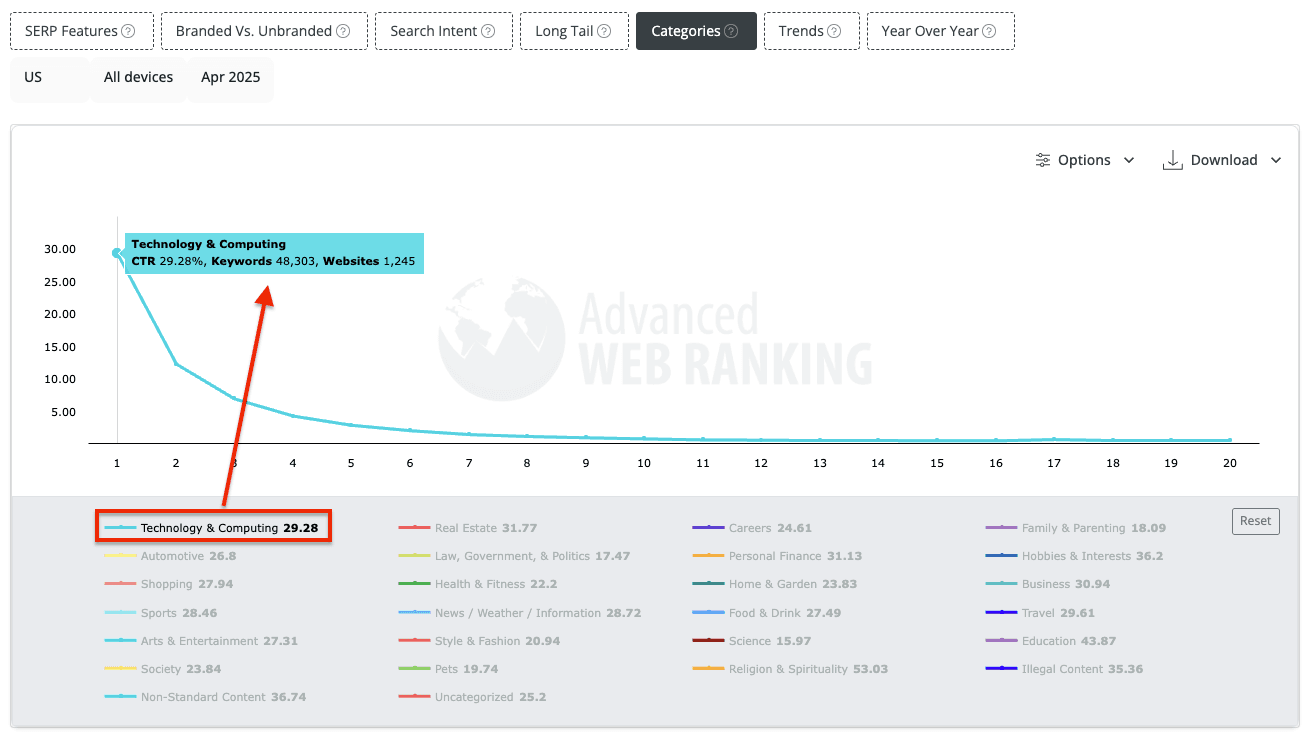
Hover over each position, and it will show the CTR, with Google positions along the X axis.
Agency Tip: For clients early in their SEO journey, stick to conservative estimates to avoid over-forecasting. This step keeps your traffic forecast grounded in reality and aligned with the client’s actual SEO capability.
Next, apply these CTRs to your keyword research.

We use our SEO Forecasting Template internally at AgencyAnalytics to apply the CTR rates for the various positions. We bundle positions 6-10 because they are close enough in CTR that averaging them out makes sense for forecast estimations.
The top-level math is simple: we are looking for total annual search volume and multiplying this by CTR per organic position to find out how many organic visits per year the client could receive:

Step 3: Estimate Leads Based on Website Conversion Rate
Now that you've forecasted potential monthly traffic from your target keywords, it’s time to apply your client’s average conversion rate.
Back to our example: You projected that potential organic traffic from new content is 2,879 annual clicks. If the client's site converts 2% of visitors into leads, that gives you 32 leads per month from these three blog posts if the client ranks in position #1 for all three.
If your client doesn’t have solid conversion data, use an industry baseline or average conversion rate for similar content types. But make sure to flag it as an assumption in your forecast.
Agency Tip: Use different conversion rates for different pages or funnel stages. A blog post might convert at 1–2%, while a landing page might hit 5%+.
Step 4: Estimate Sales Based on Lead Conversion Rate
Leads are great, but what your client cares about is revenue. So the final step is estimating how many leads convert to customers.
If your client knows their lead-to-sale conversion rate is 20%, you’re now projecting two new customers per month from this SEO campaign.
Layer in Average Order Value (AOV) or Customer Lifetime Value (CLV), and you’ve got a ballpark revenue estimate. That’s a powerful proof point when pitching long-term SEO efforts.
For example:
32 leads/month × 10% conversion = 3 new customers
Average Order Value = $5,000
Projected monthly revenue from this campaign = $15,000

This is how you turn keyword data into a business case. It takes your SEO forecasts beyond impressions and clicks, and ties them directly to outcomes that matter to your clients.
It’s important to note that this is a highly theoretical approach. Will a managed IT services provider based in NYC make $15,000 worth of revenue from three middle-of-funnel blog posts? Likely not. The client’s true conversion rates are probably different, and form fills are more likely to come from bottom-of-funnel content like whitepapers, best practices, guides, etc. Sometimes, clients don’t even know their conversion rates at various stages of the funnel, and more often than not, experience attribution issues.
Agency Tip: When using this method, always remind the client that a theoretical forecast gives them an estimate of the potential of organic search, not what will result in dollars in the bank.
2. Forecasting Using Historical Organic Traffic
Now for the second SEO forecasting method.
Keyword-based forecasting shows what your agency could earn with new rankings. But historical modeling is how you predict future organic traffic growth based on what your client has already achieved.
Using the historical traffic method is essential when:
Auditing a new client’s SEO performance
Establishing realistic growth expectations
Building a business case for investing in content, links, or technical improvements
Here’s how to forecast SEO growth using historical data:
Step 1: Gather 18–24 Months of Organic Traffic Data
Use Google Analytics and Google Search Console to pull organic search traffic from the past 18–24 months.
Look for consistent, month-over-month traffic trends. Isolate organic search traffic only, filtering out paid, referral, or direct visits.
This historical SEO data will reveal baseline patterns:
Seasonality (e.g., spikes in Q4 for ecommerce clients)
Overall growth or decline in search visibility
The impact of previous SEO efforts
Agency Tip: For multi-service clients or global brands, segment the data by service line, region, or page type. This gives you clearer insight into what’s actually driving performance.
Step 2: Remove Branded Traffic
Branded searches are great for the business, but don’t tell you much about your SEO strategy. They reflect awareness, not discoverability.
Filter out branded keywords in Search Console, or isolate non-branded landing pages in GA4. That gives you a clean, SEO-driven view of traffic earned through rankings, not reputation.
Why It Matters: A client might see a 20% lift in branded traffic and assume SEO is working, when it’s just brand momentum from paid, PR, or offline channels.
Step 3: Apply a Forecasting Model
With your non-branded data in hand, use a statistical model to project future performance.
That could be:
A trendline in Google Sheets
Linear regression or moving averages
A pre-built forecasting spreadsheet (like our SEO Forecasting Template)
Forecasting modules in a tool like AgencyAnalytics.
The goal: show what traffic will likely look like if the client changes nothing—no new content, no new backlinks, no tech improvements.
Why Both Methods Matter
To forecast SEO performance with confidence, you need more than one method. Relying on just historical data or keyword forecasts gives you an incomplete picture. The most accurate forecasting uses both to show where things are headed and where growth is possible.
Historical traffic modeling answers one question: What happens if we keep doing exactly what we’ve been doing? It’s ideal for establishing a baseline. You’ll see trends, seasonality, and past performance patterns. But it doesn’t factor in upcoming changes—like new content, technical fixes, or a revised keyword strategy. It’s a helpful snapshot, but a passive one.
Keyword-based forecasting takes a proactive approach. By layering in search volume, keyword difficulty, and CTR benchmarks, you estimate how much traffic your client could earn with improved rankings or new content. It’s forward-looking and strategic.
Used together, these methods help you answer two essential client questions:
“What kind of growth can we expect if we stay the course?”
“What kind of growth can we create if we step it up?”
This is how you turn SEO forecasts into a real strategy.
Common SEO Forecasting Pitfalls & How To Avoid Them
Even the best SEO forecasting software cannot save a flawed foundation. If you skip the fundamentals, your projections won’t hold.
Here are the most common mistakes agencies make when forecasting SEO performance and how to avoid them:
Inconsistent Forecasting Models
Clients lose trust if you constantly change how you build or present forecasts. They won’t know whether the traffic changed or the model did.
What To Do Instead: Stick to one forecasting format that your clients understand. A consistent model makes it easier to spot trends, track progress, and explain changes when traffic shifts. Clarity builds confidence.
Over-Reliance on Data
Traffic forecasting is rooted in data, but data alone doesn’t tell the whole story. Without understanding the actual context, too much focus on search volume, CTR, or estimated monthly traffic can lead to inflated projections.
What To Do Instead: Pair keyword and traffic data with insights from client conversations, competitive analysis, and user behavior patterns. Don’t just predict the future, make sure it aligns with the client’s reality.
We always craft our data stories based on what is most important to our clients. At different parts of clients' journeys, revenue growth is more important than cost savings, and vice versa, so ensuring you are on the same page is vital. This helps determine which data points are the most important.
Tom Gibson, Founder, Pilot
Ignoring External Factors
SEO lives in a shifting landscape. Algorithm updates, new competitors, changes to the search engine results pages, or even macroeconomic shifts can all impact organic traffic.
What To Do Instead: Flag external risks in your forecasting documentation. If Google rolls out another helpful content update mid-quarter, be ready to adjust. Flexible models and scenario planning go a long way here.
Inadequate Communication
Even a perfect forecast will fall flat if the client doesn’t understand how it was built. When you don’t clearly outline assumptions, data sources, or potential risks, trust takes a hit the moment results veer off track.
What To Do Instead: Share your forecast’s methodology upfront. Include how you built the model, what input data you used, and what range of outcomes are possible. Transparency builds buy-in.
Lack of Regular Updates
Forecasts aren’t fire-and-forget. If you only build it once and never update it, it becomes irrelevant fast, especially if rankings or traffic shift unexpectedly.
What To Do Instead: Treat your SEO forecast like a living document. Revisit it during monthly or quarterly reviews, compare actual vs. projected traffic, and adjust your strategy as needed.
To make that process effortless, use a platform like AgencyAnalytics. Its automated client reports automatically pull in the latest SEO metrics, so you always have fresh data to compare against your projections. With all your clients’ data in one place, including backlinks, site audits, and more, you put your entire SEO reporting on autopilot.
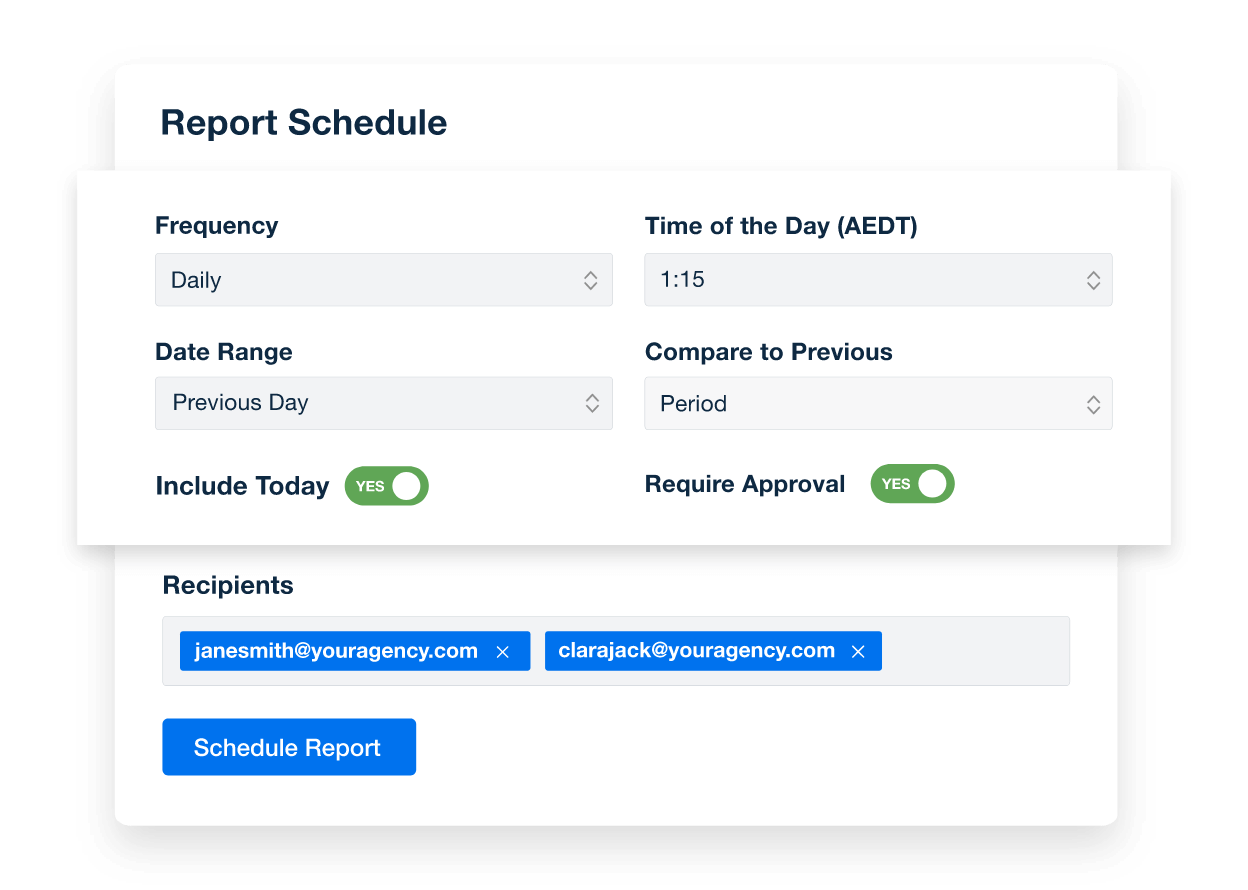
AgencyAnalytics automated client reporting. Try it free for 14 days.
The Dangers of Over-Forecasting
Time to call out one of the biggest forecasting pitfalls: over-forecasting.
Nothing sinks client trust faster than setting the bar too high—and missing it.
Over-forecasting is one of the most common and costly mistakes agencies make. It usually comes from a good place: ambition, confidence, or wanting to win the pitch. But if you overpromise and the traffic doesn’t land, your credibility takes the hit.
Creating too-high expectations sets the bar high and makes it more difficult to meet that client's expectations, more likely resulting in a failure and a churned client.
Andy Cabasso, Co-Founder, Offsprout
Here’s what to look out for and how to avoid making a mistake you can’t afford:
Unrealistic Expectations
If your traffic forecast looks too good to be true, clients will either cling to it as a guarantee or distrust it altogether. Either way, you lose.
It’s tempting to plug in top-of-funnel keywords, assume a #1 ranking, and multiply by the best-case CTR. But that kind of traffic forecast often ignores the grind it takes to get there, and sets your team up for a tough conversation later.
Keep It Real: Present a range (conservative, expected, aggressive), or clearly label projections as hypothetical based on ranking assumptions.
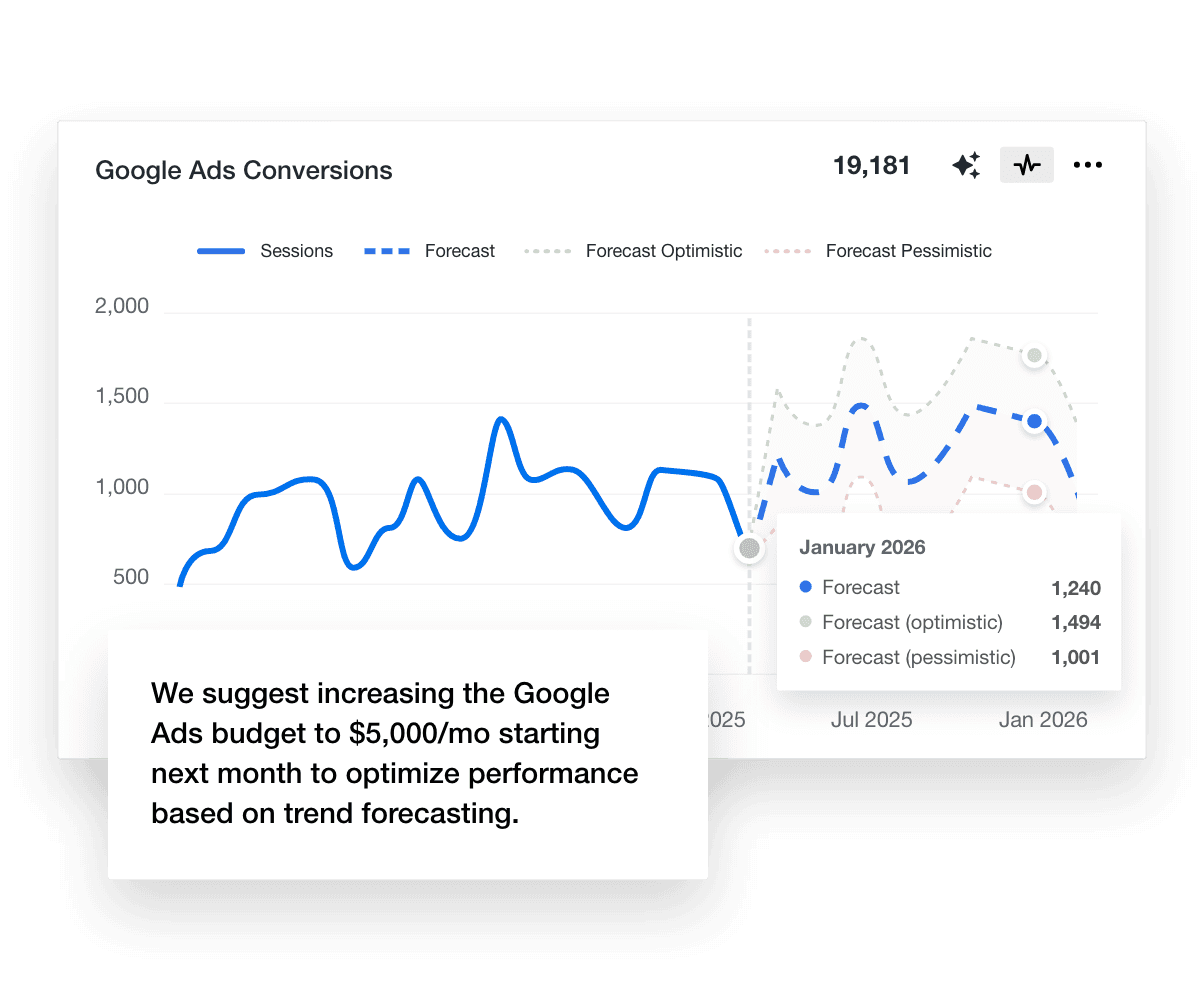
Data Limitations
Forecasts based on historical data miss what’s coming around the corner, especially if external factors like search engine algorithm updates, competitive shifts, or changes in search intent are ignored.
Stay Adaptive: Always combine backward-looking data with forward-facing insights. Keyword trends, seasonality, and competitor movement all shape future performance.
Lack of Flexibility
Static models don’t hold up in a dynamic search environment. A forecast built six months ago won’t reflect today’s SERP features, AI changes, or even a sudden loss of backlinks.
Be Ready To Pivot: Build your forecasts to be revisited, challenged, and updated. When your model adapts, your strategy stays agile, and your clients remain confident.
Over-forecasting turns your agency from a strategic partner into a source of disappointment. Keep your forecasts grounded, and clients will stick around for the long game.
Top SEO Forecasting Tools & Software
Speed matters when building forecasts, especially when clients want answers yesterday. The right SEO forecasting tools help you cut through the complexity and make faster, smarter decisions.
Here’s a breakdown of tools to consider, starting with the one built specifically for agencies.
AgencyAnalytics
AgencyAnalytics is a reporting and forecasting platform built specifically for marketing agencies. Alongside core features like rank tracking, backlink monitoring, and SEO dashboards, it includes forecasting capabilities designed to turn client data into strategic decisions.
The platform helps agencies forecast SEO performance by combining historical data with trend analysis, CTR benchmarks, and industry comparisons across 150,000+ campaigns. It also includes automated alerts to flag anomalies and AI-powered recommendations to guide next steps.
What sets it apart is its balance of forecasting insights with hands-off, client-ready reporting. For agencies managing multiple accounts and needing to deliver clear, data-backed projections without manual work, it’s a practical, agency-first choice.
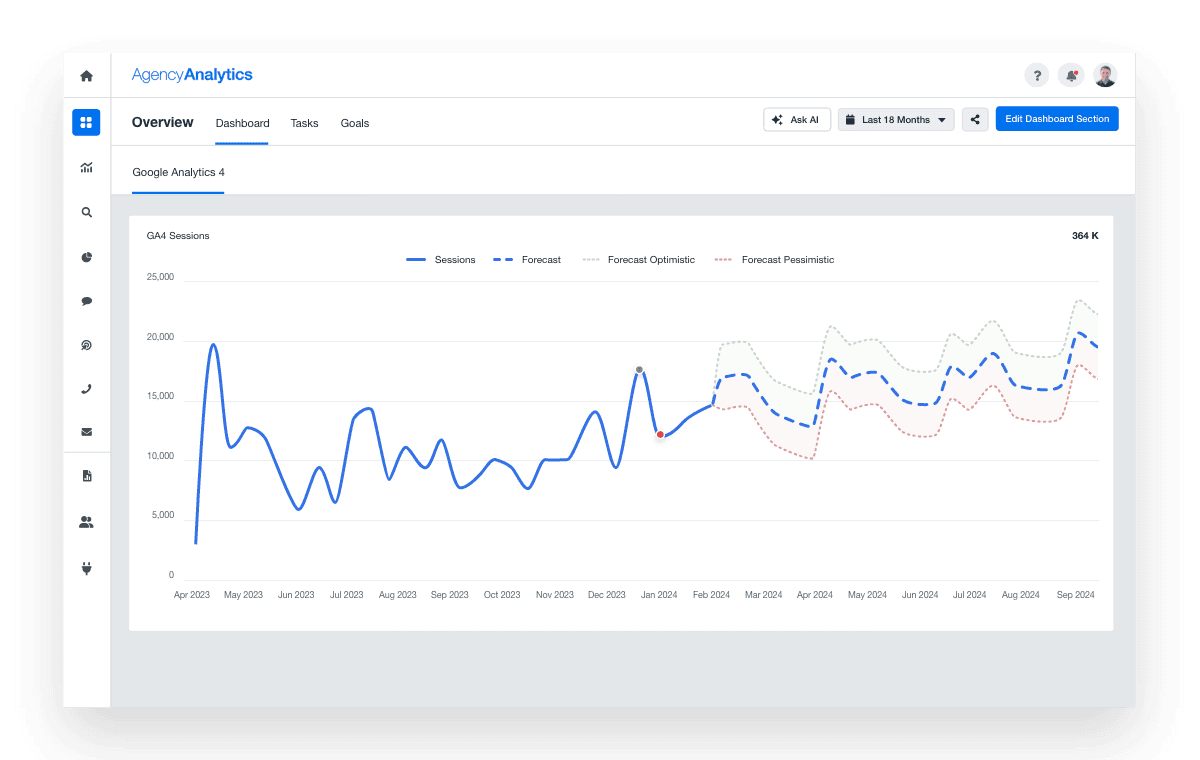
Here’s how AgencyAnalytics helps you forecast with clarity and confidence:
Benchmark Performance Against 150,000+ Agency Campaigns: Set realistic client goals by comparing keyword rankings, CTR, and traffic metrics to industry standards, so you’re forecasting in context, not in a vacuum.
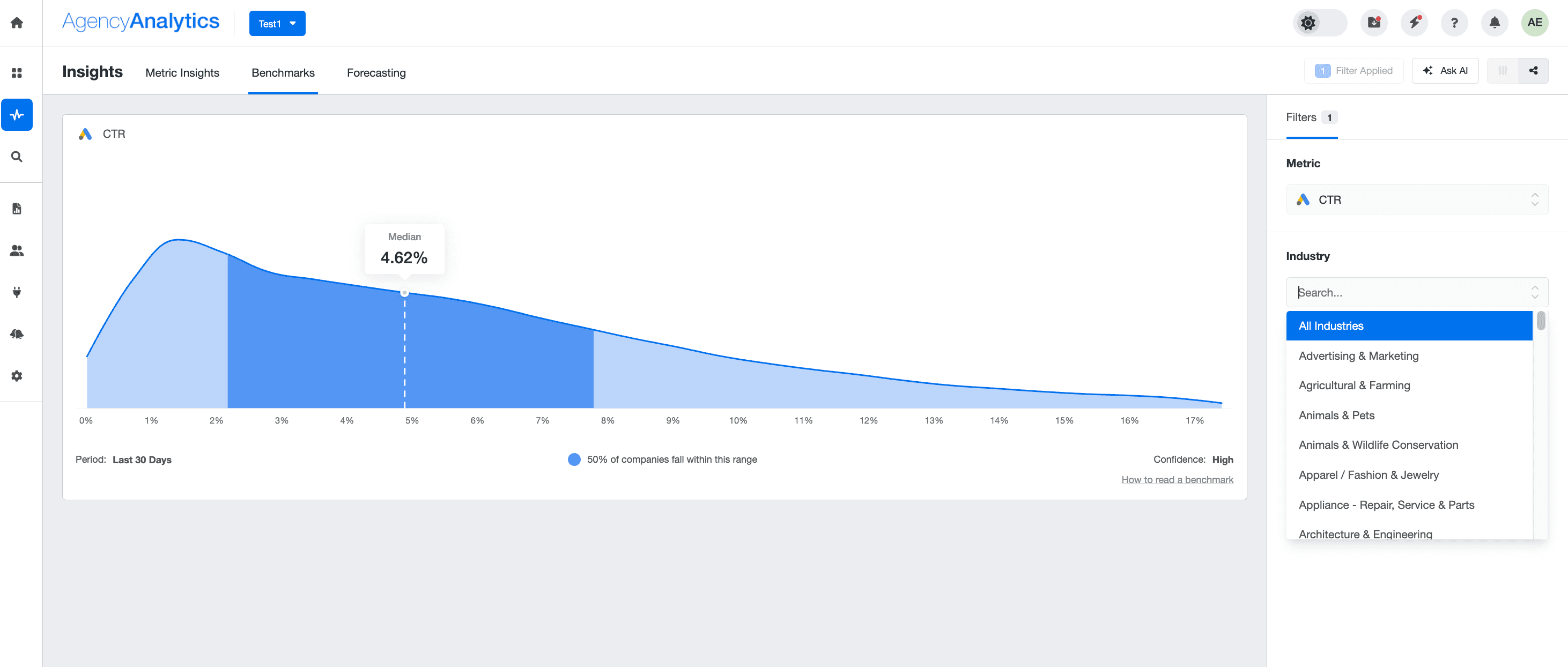
Use Trend Forecasting To Guide Strategic Planning: Predict future performance based on historical SEO data. Build forecasts that inform smarter budget and resource allocation across clients and campaigns.

Catch Anomalies Before They Impact Results: Automated alerts help you detect performance spikes or drops early. Spot the trend before it becomes a problem, and adjust your strategy in real time.
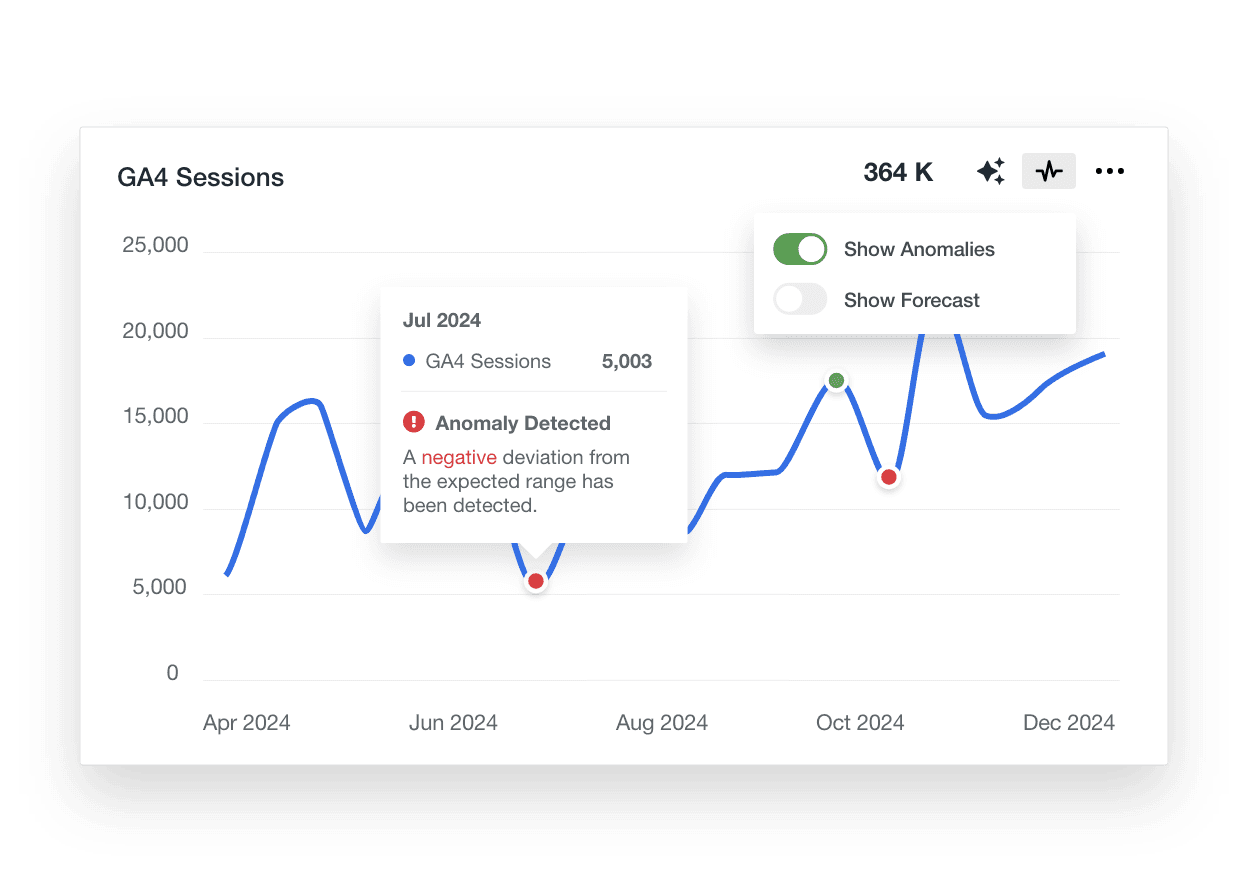
Let AI Recommend Your Next Best Move: Get AI-powered suggestions to optimize campaigns, improve SEO performance, and hit your client’s goals faster.
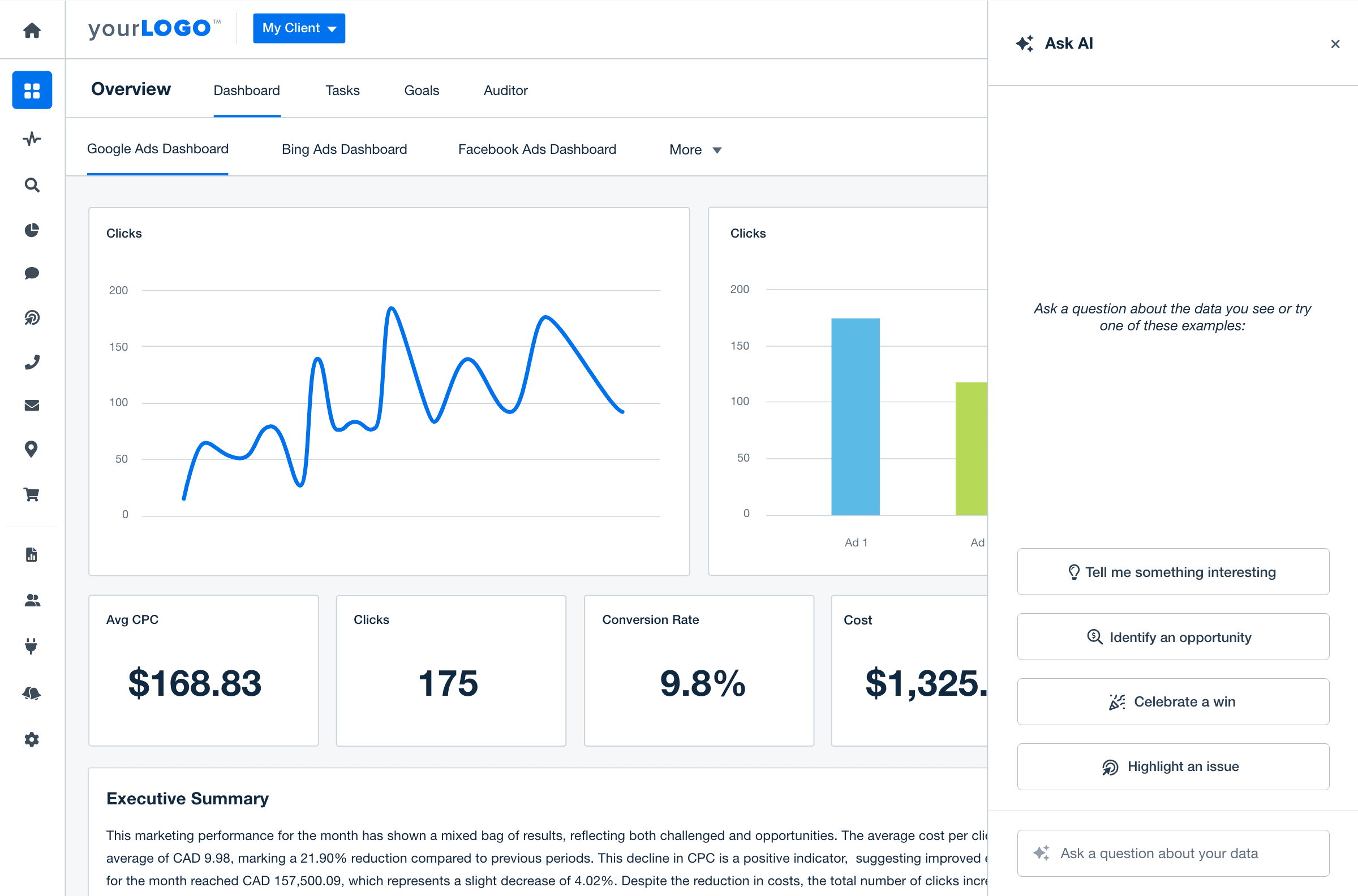
If you're looking for a forecasting solution built specifically for client-facing SEO work, AgencyAnalytics brings the right mix of data, context, and ease of use.
SERanking
SERanking includes traffic forecasting as part of its broader SEO toolkit, which also covers rank tracking, backlink monitoring, site audits, and on-page SEO tools. While it’s not a forecasting-first platform, it offers basic models that estimate potential traffic based on current rankings and keyword search volume.
It’s a good fit for small to mid-sized agencies already using SERanking for daily SEO tasks and reporting. If forecasting isn’t your main focus, but you want quick, integrated projections without switching tools, this could be a practical option.
TrafficProjection
TrafficProjection is a niche tool built solely for keyword-based traffic forecasting. It allows you to plug in keyword rankings and CTR assumptions to generate fast traffic projections, ideal for SEO pitches, quick what-if models, or early-stage forecasting.
Its simplicity is both a strength and a limitation. You’ll get straightforward outputs, but no additional features like keyword research, historical trend analysis, or campaign performance tracking. It’s best suited for agencies that need fast projections, not full-platform depth.
SEOmonitor
SEOmonitor stands out for its dedicated forecasting module, which estimates traffic potential based on keyword visibility, search volume, and ranking trends. It’s particularly strong in modeling scenarios tied to keyword clusters and share-of-visibility goals.
This makes it a solid choice for SEO-first agencies managing long-term campaigns, especially when forecasting is a core part of the strategy. That said, it requires more setup and manual configuration than all-in-one platforms, so it’s best for teams who need advanced forecasting power and don’t mind the learning curve.
seoClarity
seoClarity is an enterprise-grade SEO platform with forecasting built into a broader suite that includes content optimization, technical audits, rank tracking, and AI-driven insights. The platform excels at giving large teams visibility across thousands of pages and keywords, with forecasting tied into real-time site performance data.
It’s a strong fit for agencies or in-house teams managing complex SEO operations across multiple sites, regions, or verticals. But its robust feature set might be overkill for smaller teams that need a leaner, more focused solution.
BrightEdge
BrightEdge combines SEO forecasting with opportunity modeling, content recommendations, and revenue attribution. It’s positioned as a performance-driven platform for enterprises that need to connect SEO outcomes to business metrics like pipeline value, conversions, and ROI.
The platform offers deep integrations with CRMs, marketing automation platforms, and analytics tools, making it especially valuable for brands with mature marketing stacks. That said, the learning curve and implementation overhead may be more than what fast-moving agencies or smaller marketing teams want to take on.
Final Thoughts
When you combine historical modeling with keyword-based forecasting, you give clients a clear picture of both their current trajectory and what’s possible with the right SEO strategy. That clarity builds trust, improves retention, and sets your agency apart from competitors who still rely on vague promises.
But even the best forecast falls flat without the right tools to back it up.
That’s where AgencyAnalytics comes in. From AI-powered insights to automated client reporting, you’ll always have fresh data to validate your projections and real-time visibility into what’s working, what’s trending, and what to do next.
Ready to forecast with confidence?

Written by
Carson Crane is the chief SEO Strategist at AgencyAnalytics. A 15+ year digital marketing veteran, his work has driven millions in revenue for B2B, B2C, DTC and enterprise companies as large as Allstate Insurance, American Bureau of Shipping, Seagate and SAP.
Read more posts by Carson CraneSee how 7,000+ marketing agencies help clients win
Free 14-day trial. No credit card required.




